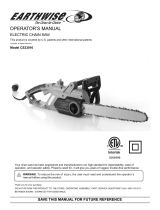
Deutsch (Übersetzung der originalen Anleitungen)
13
English (Original instructions)
these instructions to operate the power tool. Power
tools are dangerous in the hands of untrained users.
e) Maintain power tools. Check for misalignment or
binding of moving parts, breakage of parts and any
other condition that may affect the power tool’s
operation. If damaged, have the power tool repaired
before use. Many Accidents are caused by poorly
maintained power tools.
f) Keep cutting tools sharp and clean. Properly
maintained cutting tools with sharp cutting edges are
less likely to bind and are easier to control.
g) Use the power tool and accessories in accordance
with these instructions, taking into account the
working conditions and the work to be performed.
Use of the power tool for operations different from
those intended could result in a hazardous situation.
SERVICE
Have your power tool serviced by a qualified repair
person using only identical replacement parts. This will
ensure that the safety of the power tool is maintained.
If the replacement of line supply cord is necessary, this
has to be done by the manufacturer or his agent in
order to avoid a safety hazard.
OTHER GENERAL WARNINGS
Know your power tool. Read owner’s manual
carefully. Learn its applications and limitations as well
as the specific potential hazards related to this tool.
Use the right tool. Do not force small tool or
attachments to do the job of a heavy duty tool. Do not
use the tool for purposes not intended.
Protect your lungs. Wear a dust mask if operation is
dusty.
Do not operate in poor lighting. Use the unit only in
daylight or good artificial light.
Pull the plug immediately if the mains or extension
lead is damaged or severed.
Stay alert and exercise control. Watch what you are
doing and use common sense. Do not operate tool
when you are tired. Do not rush operation of the tool.
Check for damaged parts. Inspect your before every
use. Check for alignment of moving parts, binding of
moving parts, breakage of parts, mounting and any
other conditions that may affect its operation. Any
part that is damaged should be properly repaired or
replaced by an authorised service centre.
Do not use the tool if the switch does not turn it on
and off. Have defective switches replaced by an
authorised service centre.
Do not operate this tool while under the influence of
drugs, alcohol or any medication.
The appliance is not intended for use by young or
infirm persons.
Young children should be supervised to ensure that
they do not play with the appliance.
The use of an earth-leakage circuit breaker of
residual current device in conjunction with this tool is
recommended.
Maintain the chain saw with care. Keep the cord
clear of the chain at any time. Never carry the saw by
the cord or pull on the cord to disconnect it from the
socket.
Chain tension. Make sure that the chain tension is
correct, as specified in these instructions. Incorrect
tension may cause the chain to disengage from the
guide bar, which is extremely dangerous.
Power cord : if the replacement of the supply cord is
necessary, this has to be done by the manufacturer or
his agent in order to avoid a safety hazard.
Extension cord. When an extension cord is used
make sure:
(a) That pins on the plug of the extension cord are
the same in number, size and shape as those of
the plug on the saw.
(b) That extension cord is properly wired and in good
electrical condition.
(c) That the wire size is large enough for the AC
power rating of the chain saw.
CHAIN SAW SAFETY WARNINGS-SPECIAL
SAFETY INSTRUCTIONS
Keep all parts of the body away from the saw chain
when the chain saw is operating. Before you start the
chain saw, make sure the saw chain is not contacting
anything. A moment of inattention while operating
chain saws may cause entanglement of your clothing
or body with the saw chain.
Always hold the chain saw with your right hand
on the rear handle and your left hand on the front
handle. Holding the chain saw with a reversed hand
configuration increases the risk of personal injury and
should never be done.
Wear safety glasses and hearing protection. Further
protective equipment for head, hands, legs and feet
is recommended. Adequate protective clothing will
reduce personal injury by flying debris or accidental
contact with the saw chain.
Do not operate a chain saw in a tree. Operation of a
chain saw while up in a tree may result in personal
injury.
Always keep proper footing and operate the chain
saw only when standing on fixed, secure and level
surface. Slippery or unstable surfaces such as
ladders may cause a loss of balance or control of the
chain saw.
When cutting a limb that is under tension be alert
for spring back. When the tension in the wood fibres





















